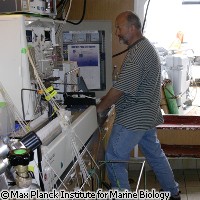Bacteria clean up toxic fishing waters
An international team of researchers has found that hydrogen sulphide, which is toxic to many forms of life including economically important fish, is often 'cleaned up' by blooms of sulphide-oxidising bacteria in deep waters, effectively concealing vast areas of oxygen-depleted waters from current monitoring systems. Their findings, published online in the journal Nature, have implications for the management of agricultural pollution in coastal waters. 'Coastal waters support 90% of global fisheries and are therefore an important food reserve for our planet,' the authors explain. When chemical nutrients such as nitrogen and phosphorous (i.e. fertilisers) enter these waters, oxygen levels are severely depleted. The process, called eutrophication, also leads to rapid increases in levels of poisonous hydrogen sulphide, with disastrous consequences for coastal ecosystems. Agricultural runoff is not the only cause of eutrophication: increased atmospheric nitrogen, caused by human activity, routinely enters the open ocean, accounting for up to a third of the ocean's non-recycled nitrogen supply. Whatever the cause, the bottom line is that it leads to toxic episodes that kill fish and shellfish, reducing catches and threatening biodiversity. A team led by Dr Marcel Kuypers of the Max Planck Institute for Marine Microbiology in Germany investigated the Benguela system on the African shelf, off the coast of Namibia, to discover the extent and development of a hydrogen sulphide 'episode'. They took samples from various depths over a large area and found that the toxic compound covered 7,000 square kilometres, although the surface water seemed fine. They monitored the episode over time and found that the sulphide disappeared at certain depths, and in some places it sank deeper into the suboxic zone, where oxygen is depleted. 'This apparent sulphide sink in the suboxic zone strongly suggests that sulphide was oxidised anaerobically in the water column,' the study reads. Environmental scientists use a 'water column' model to understand the character of different layers of water; for example, organisms living on the bottom of the sea (benthos) are dependent on a particular range of pH, pressure and salinity, rather than on an average of these values between the bottom and surface of the water. The scientists reasoned that because nitrate, in the absence of oxygen, is best suited to oxidising sulphide, and because there was overlap between nitrate and sulphide around 90 metres below, in the suboxic zone, there must be some meaningful interaction occurring. They observed similar concentrations of ammonium and sulphide in the bottom water, but saw that ammonium disappeared (or was oxidised anaerobically) just above the sulphide. 'Obviously it was oxidised anaerobically - without oxygen,' explained Torben Stührmann of the Max Planck Institute for Marine Microbiology. 'Many bacteria do not require oxygen for respiration and can use nitrate instead. And indeed - we found a water layer that contained both hydrogen sulphide and nitrate.' Anammox (anaerobic ammonium oxidation) bacteria have recently been shown to be responsible for massive nitrogen loss in these waters. Armed with this knowledge, the researchers looked at their samples to see whether bacteria were somehow metabolising the hydrogen sulphide. They conducted extensive chemical and genetic analyses and discovered that two different kinds of proteobacteria were involved in 'chemolithotrophic' oxidation of sulphide, using nitrate. Lithotrophs are nature's sulphur and nitrogen recyclers; chemolithotrophs are deep-sea dwelling bacteria living in other organisms; they may have evolved from a kind of cyanobacteria. The proteobacteria found in this study are apparently related to Candidatus Ruthia magnifica, a bacteria living in a vent- and seep-dwelling mussel. By oxidising hydrogen sulphide in the sea, the bacteria effectively created a buffer zone between the oxygen-rich surface waters and the deeper toxic waters. The scientists participating in the current study showed that the bacteria cleaned up an area three times the size of Luxembourg; this is the first demonstration of such a large-scale bacterial detoxification of sulphide-rich waters in the open ocean. The importance of their finding is significant: monitoring the seas for toxic events relies on technologies that penetrate only as far as the surface waters. If bacteria are cleaning up after eutrophic events in deeper waters, the extent of these events becomes very difficult to monitor accurately. 'There is a very positive as well as a worrying aspect of our discovery of a gigantic bacterial bloom detoxifying hydrogen sulphide,' said Dr Kuypers. 'Hydrogen sulphide is toxic to higher life and even at low concentrations it will instantly kill fish, oysters, shrimps and lobsters. The good news is that the discovered groups of bacteria seem to consume the hydrogen sulphide before it reaches the surface waters where fish are living. It is worrying news, however, that an area the size of the Irish Sea or the Wadden Sea was affected by sulphidic bottom waters, without this being visible on satellite photos or detected at the monitoring stations closer to the coast.' Current estimates indicate that shelf hypoxia will strongly increase in coming decades, both because of human-induced eutrophication and global warming. However, according to Dr Gaute Lavik of the Max Planck Institute for Marine Microbiology, 'the fact that we can correlate sulphidic waters with certain environmental conditions might provide an opportunity to forecast these events in the future.'
Countries
Austria, Germany, Namibia, Sweden

